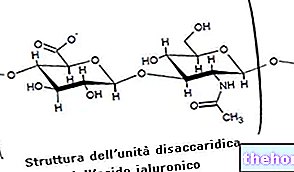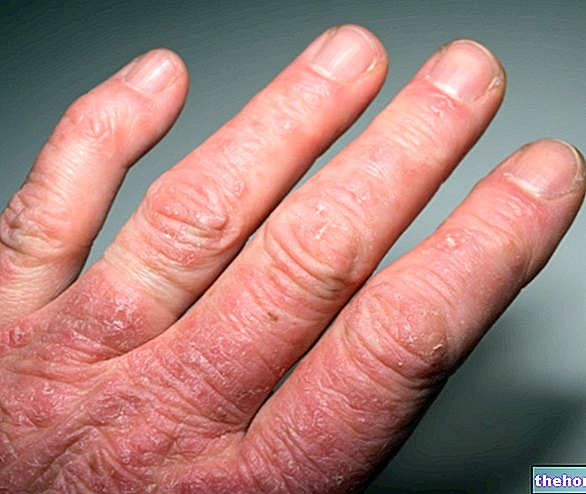Generality
Osteophytosis is the process of forming osteophytes at the skeletal level.
Similar to a rose thorn, a beak or a claw, osteophytes are small bony growths that develop on the articular surfaces of bones subjected to chronic erosive and irritative processes.
Osteophytosis mainly affects the bony portions that make up the knee joint, the hip joint, the spinal joints, the shoulder joint and the finger joints.
The symptoms of osteophytosis depend on where the osteophytes form.
For an accurate diagnosis, X-rays and nuclear magnetic resonance are essential.
The treatments for osteophytosis include: the administration of NSAIDs, paracetamol and / or corticosteroids, physiotherapy and surgery to remove osteophytes.

What is osteophytosis?
Osteophytosis is the term that, in medicine, indicates the process of formation of osteophytes at the skeletal level.
Osteophytes - or bone spurs - are small bony projections, most often similar to a rose thorn, a beak or a claw, which develop along the joint margins of bones subjected to chronic erosive and irritative processes.
Generally, osteophytosis concerns the portions of the bones that give rise to the joints (the joint margins mentioned in the previous period).
The joints most prone to osteophytosis include: the knee joint, the spinal column joints, the hip joint, the shoulder joint and the finger joints.
TYPES OF OSTEOPHYTOSIS
The phenomena of osteophytosis can lead to the formation of osteophytes oriented towards the inside of a joint or to the formation of osteophytes oriented towards the outside of a joint.
In medicine, the first condition is called central osteophytosis, while the second is known as marginal osteophytosis.
Causes
According to the most recent scientific studies, osteophytosis would consist of a phenomenon of bone neo-apposition, triggered in response to damage to the articular cartilage. In other words, therefore, osteophytosis would represent a consequence of the degeneration of the articular cartilage.
BRIEF REVIEW OF WHAT "IS ARTICULAR CARTILAGE
Articular cartilage is the elastic tissue, located at the end of the bones that take part in the joints. Composed of chondrocytes, it has a remarkable resistance to pressure and traction.
Its functions are: to act as a shock absorber bearing, whenever a joint is the protagonist of shocks of a certain intensity, and to reduce the friction existing between the ends of the two bones that participate in a joint.
WHAT CONDITIONS DOES IT DEPEND ON?
The main cause of osteophytosis is osteoarthritis. Osteoarthritis, or arthrosis, is the most common type of joint inflammation (arthritis) in humans. The inflammatory process characterizing osteoarthritis derives from the deterioration of the aforementioned joint cartilage.
Other possible causes of osteophytosis, certainly less common than osteoarthritis, are: aging and all joint inflammations that lead to a degeneration of the articular cartilage (rheumatoid arthritis, gout, etc.).
Symptoms and Complications
Osteophytosis very often lacks an associated symptomatology; in other words, it is generally asymptomatic.
When osteophytosis causes symptoms, the clinical manifestations depend, for easily understood reasons, on the location of the osteophytes.
For instance:
- Knee osteophytosis. The typical symptoms of knee osteophytosis consist of: pain during full extension of the lower limb and reduction of joint mobility;
- Hip osteophytosis. The classic symptoms of hip osteophytosis consist of: pain during movement of the hip and reduced joint mobility.
- Shoulder osteophytosis. In general, osteophytosis of the shoulder produces osteophytes in the vicinity of the rotator cuff, preventing its correct functioning and compromising the health of the constituent elements (NB: the rotator cuff is a group of muscles and tendons, essential for correct movements shoulder).
Shoulder osteophytosis can be the cause of very painful and swollen tendinitis. - Osteophytosis of the hands. Osteophytosis of the hands produces subcutaneous swellings, which are located at the level of the interphalangeal joints of the fingers.
Noticeable to the touch, the osteophytes in the hands give the fingers a gnarled appearance.
There are two categories of osteophytes in the hands: the so-called Bouchard's nodules and the so-called Heberden's nodules. Bouchard's nodules are osteophytes of the fingers of the hands located at the level of the proximal interphalangeal joints; Heberden's nodules, on the other hand, are osteophytes of the fingers of the hands located at the level of the distal interphalangeal joints. - Spinal osteophytosis. Spinal osteophytosis can cause osteophytes to appear inside the space where the spinal cord resides (the so-called spinal canal), causing it to narrow. The presence of osteophytes in the spinal canal can affect nerve signaling through the spinal nerves, causing disturbances in sensory and motor functions. Sensory function disorders include: pain, numbness, tingling and burning sensation in the upper or lower limbs.On the other hand, motor function disorders include: muscle spasms, cramps, a sense of weakness and loss of muscle control.

Heberden nodules - Image from en.wikipedia.org
WHEN TO SEE THE DOCTOR?
Osteophytosis is a condition that should be brought to the attention of the physician when it is responsible for: intense pain, severe motor difficulties affecting the affected joints, accentuated swelling and, in the case of osteophytosis of the spine, disturbances in the sensory and motor functions.
Diagnosis
For a correct diagnosis of osteophytosis of the hands, a thorough physical examination is sufficient.
To identify episodes of osteophytosis in other parts of the body, instead, it is necessary to resort to diagnostic imaging and, in this case, to X-rays and nuclear magnetic resonance.
ASYMPTOMATIC OSTEOPHYTOSIS AND RANDOM DIAGNOSIS
Asymptomatic osteophytosis is a condition that, very often, doctors diagnose by pure chance, for example during an X-ray check of the anatomical part concerned, carried out for other reasons.
Treatment
Osteophytosis requires therapy when it causes symptoms; if it is asymptomatic, doctors do not prescribe any type of treatment.
The treatment of symptomatic osteophytosis includes:
- The administration of NSAIDs, ie non-steroidal anti-inflammatory drugs. By reducing the inflammatory state, these medicines also reduce the painful sensation felt by the patient.
Among the most used NSAIDs in case of osteophytosis, ibuprofen and sodium naproxen deserve a mention; - The administration of paracetamol, with pain relieving purpose. Paracetamol is also an anti-inflammatory drug;
- The administration, through direct injections into the painful joints, of corticosteroids. Corticosteroids are powerful anti-inflammatory drugs, the prolonged use of which could lead to several side effects. For this reason, doctors only prescribe them when NSAIDs have been ineffective and the pain is still present;
- Physiotherapy exercises. Physiotherapy for osteophytosis includes muscle strengthening and stretching exercises and joint mobility exercises.
A good physiotherapy can considerably relieve the painful sensation, especially during the movements of the joint affected by the osteophytes; - Surgical removal of osteophytes. In general, surgery occurs when osteophytosis affects the spine.
Doctors opt for the surgical removal of osteophytes only in extreme cases and only when all other remedies have proved ineffective.
Prognosis
The prognosis in case of osteophytosis depends, firstly, on the presence or absence of symptoms and, secondly, on the severity of the latter.
An "asymptomatic osteophytosis is a condition that does not affect the daily life of patients, who, very often, are unaware of being affected by it.
A symptomatic osteophytosis, on the other hand, is a disease with large consequences on everyday life: patients who suffer from it feel pain even during very simple movements or suffer from annoying disturbances to the sensory or motor functions.
Fortunately, recent medical advances have made excellent symptomatic remedies available to osteophytosis patients.




























